Rolf Potts's Blog, page 84
August 10, 2012
Vagabonding field reports: a meditation retreat in Thailand
Vagablogging :: Rolf Potts Vagabonding Blog
 The 10 day silent meditation retreat I attended last July in Wat Khao Tham, a monastery in Ko Phangan, Thailand, was my 4th experience of this sort, all but one of them in the land of smiles, each of them in a different temple.
The 10 day silent meditation retreat I attended last July in Wat Khao Tham, a monastery in Ko Phangan, Thailand, was my 4th experience of this sort, all but one of them in the land of smiles, each of them in a different temple.
In this website there is already a guide to Meditation Retreats in Thailand, that I recommend you reading to get a good picture and “Find your own damn Buddhist meditation retreat!“
Let me just state that you don’t need to convert to Buddhism to attend a retreat. Meditation is essentially about mental development and the benefits of a retreat, from the simple detox from the noises of daily life, to the permanent gains in your insight (this is the meaning of the word Vipassana, that many confuse as a technique) vision are huge.
If you are interested in reading the day by day diary of my experience you can read it on my blog. Here is an overview of my experience:
Cost/day: While most centers ask just for a free donation, in Wat Khao Tham the least contribution requested was 500 Thai Baht a day (15US$).
What’s the strangest thing you’ve seen lately?
It’s strange to me that there are still so many misconceptions around meditation and his identification with Buddhism, like there are people that identify yoga with Hinduism or fasting with Muslims or (insert what you find more appropriate) with any Christian related religion.
In other words mix something with the context where it has developed, or maybe I should just call this things with more propter names: ignorance and superficiality.
Describe a typical day: with slight changes on day 1, 9 and 10, this was the daily schedule of the retreat.
4.00: morning bell
4.45: sitting meditation
5.15: stretching
6.15: sitting meditation
7.00: breakfast
8.15: working meditation
9.00: walking meditation
9.30: talk teachers lecture and sitting
10.15: sitting or standing meditation
10.25: teachers instructions
10.30: walking
11.00: lunch
13.00: Walking
13.45: Sitting or standing
14.45: Walking
15.30: Sitting
16.15: Sitting or Standing
16.30. walking
17.15: light dinner
18.15: sitting
18.45: standing or walking
19.15. teachers talk + meditation in the hall or rest in the room
21.00: lights out
Describe an interesting conversation you had with a local:
Not talking for ten days may look the hardest thing to do for some, but being silent allow you to get rid of all the noises that cover the ability to really listen, especially your inner voice. During the retreat, except the short interviews with the teachers, the only person you have conversation is the part of you that the conditioning you received during your life has been relegated on a hidden corner. This “local” has many interesting things to tell you!
What do you like about where you are? Dislike?
I disliked so many things: the obnoxious mosquitos, the scorching heat, the uncomfortable wooden floor of my bungalow that act as my bed, falling asleep during meditations, finding every excuse to be distracted especially during teacher talks, being so judgemental and unforgiving with me and others.
Indeed, I ultimately like them all as an opportunity to develop my mindfulness and compassion.
You don't attend a meditation retreat for his comfy bed
Describe a challenge you faced:
The whole retreat is a challenge. But not being a novice, this time the real challenge to me was getting to the island: three days before the retreat I caught a bad cold (may be forever damned forgiven who keep air con so low in buses and malls, with much unnecessary damage to the environment and the health of people) and spent the day in bed in Marco Ferrarese my temporary place in Penang, more than 500km away. The day after I was still feeling like a wreck, when I started the long journey to Surat Thani. The first night in the Monastery I couldn’t sleep, overwhelmed by tiredness and adapting to the hard floor. All that surely made for a rough start and after three days of the retreat, the cherry on the cake was a heat stroke, that made me really close to call it a day and quit. Luckily I didn’t and from there everything was downhill. Actually only one person, injured on his knee, left before the end of the retreat.
What new lesson did you learn?
While meditation surely boost your mental development, your ability to concentrate and being mindfulness, his primary goal is to help you develop compassion. The progresses you made if you became able to sit down in a lotus position and don’t move a muscle for an hour are very little compared to experience a real compassion for yourself and the world around you that start from understdanding who you are and how things are really are and not how we want them to be or we believe are supposed to be.
Where next?
From a Thai monastery to another: I am going to take a 21 (at least) day long course in Wat Tam Mua, near Mae Hong Son and the Burmese border. In between retreats I spent time in Penang and Jakarta, experiencing the horrible traffic and pollution of Asian cities and living in a muslim country during Ramadan.
Original article can be found here: Vagabonding field reports: a meditation retreat in Thailand
Heeding the call: Stumbling into Shakespeare’s cellar
Vagablogging :: Rolf Potts Vagabonding Blog
In this second in a series on the realities of being a being a travel writer, I want to mention something that is not only important to travel writing, but to the essence of good travel itself: Be open to surprising detours.
Case in point: A couple years ago I received an assignment to visit England’s Duxford Royal Air Force Base, a historic airfield in the countryside just outside of Cambridge. Duxford is part of the Imperial War Museum and hosts the world’s premier collection of vintage warplanes. I was to write about the base, its history (it played a significant role in WWII) and its amazing array of famous fighters.
While making my way north from London, I made a point to stop at one of my favorite places, the charming town of Stratford-Upon-Avon. The picturesque town, about a hundred miles from the capital, is known the world over for its Shakespeare connection: The great man himself was born here (his childhood home is still there) and then retired to a nearby home after his dazzling career in London.
It was during my visit to Stratford (which was intended to be a quick one) that I heard about an archeological excavation being done at the site of New House, the home where Shakespeare spent in his final years. The home was demolished in the 1800’s, and took with it information about the man’s last decades.
Overseen by the Birmingham University Archeological Unit, the dig aimed to get some answers about the man behind the legend. To do that, large swaths of the property were being excavated. I took one look at the historic undertaking and decided I needed to find a way to be involved.
I introduced myself to the lead archeologist and got in touch with the head of the project. I explained that I was a visiting American travel writer and that I’d love to write an article about the dig. I asked to assist on the excavation in order to get a better feel for the project. Before I knew it, I had been ushered onto the grounds, issued a yellow vest, and given a quick tutorial in proper excavating.
The next day I was kneeling in the dirt, sweating heavily under the sweltering summer sun and scraping centuries of dirt from Shakespeare’s cellar floor. Trowel in hand, I followed the exposed lines of Elizabethan brickwork with my eyes. These lines formed the foundations of the Bard’s final home. It was thrilling to be a part of uncovering history.
My tenure as a pseudo-archeologist ended a week later when I decided I had all the research material I needed (translation: I was tired, sunburned, and out of clean clothes). I turned in my trowel and headed northward for the Duxford base.
I kept the yellow vest, though.

The author diligently sifting through Shakespeare's dirt.
The Duxford visit went well, and the resulting story was successful. But the Shakespeare article remains one of my favorite pieces, and the experience was one of a kind. There were other incidents related to that visit, but those will not make it into the pages of a travel publication anytime soon. And none of them have happened if I hadn’t kept my antennae alert for a good story and then made the effort to get involved.
The moral of the story is that while a travel writer must get his story, he also must listen when a better one calls out.
Heed the call.
Original article can be found here: Heeding the call: Stumbling into Shakespeare’s cellar
August 8, 2012
What’s outside your window?
Vagablogging :: Rolf Potts Vagabonding Blog

photo credit: flicker/creative commons (pringnews.com)
The Paris Review is running a blog series called “Windows on the World” and asking writers peppered across the globe what they see outside their window. Which reminded me that part of my favorite thing about traveling is the view outside the window changes. Even beyond seeing, different ones let in various smells, sounds and the occasional unwanted bug.
From a hostel room one winters eve, I watched a candlelight procession stroll by the tallest Christmas tree in the world. A different morning a grizzly bear keenly pried apart my dogs’ house in search of the bits of food Calise had stashed for later. But perhaps the most surprising was when a five-foot iguana slipped through a ventilation window and joined me in the shower!
So in the spirit of all you readers being scattered across the globe, please share…
What’s outside your window?
Original article can be found here: What’s outside your window?
August 7, 2012
Reflections on Hitching a Ride in Asia
Vagablogging :: Rolf Potts Vagabonding Blog
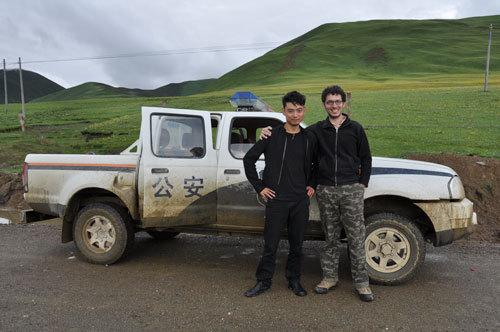
Chinese police: serving the law and taking me for a ride - picture by Kit Yeng Chan, 2012
Hitching a ride was, is and always will be evoking images of young, reckless, crazy travel. It is for adventurers, because you do not know who will pick you up and when you will arrive at your destination. And it is indeed for adventurous drivers too: our imagination is so full of hideous stories based on this phenomenon that, before you would pick up that random guy standing at the crossroad, you would definitely think twice.
Luckily, this kind of popular culture has not invaded the Asian media as much as the Western ,and seeing a foreigner at the side of the road generally does not ignite serial killer’s thoughts: on the contrary, it is quite easy to be picked up and helped out.
You may think that only someone with a very low civic sense or a very desperate need for money would be thinking of hitching in Asia. Sorry friends, but you are dead wrong: there are many people, surprisingly foreigners and local Asians alike, thumbing at the side of those roads.
Furthermore, in countries with a big exponential growth such as China, where transportation and fuel prices have doubled or tripled since the last decade, buying bus and train tickets to get around can be killer for low budgets. Hitching is on the contrary a great way to travel the extra mile, trying to have a more authentic experience observing what actually happens inside of those Asian cars you do not have to pay for. Sounds strange, isn’t it? Well, it is not, in reality: you just have to try.
The same opinion is shared by a young French guy I met recently; he arrived to China fromT urkey thumbing along the Caucasus andCentral Asiafor four months. He claims that he not only got lifts, but also met people and got to visit their homes, was invited for dinner or sleeping over, and overall he had a fantastic, genuine vagabonding time.
Westerners are not the only ones: the biggest number of hitchers I recently met is constituted by Chinese students in their early 20s to 30s. They complained that transportation costs inChinabecame unbearable, thus they are forced to hitchhike if they want to get out and travel their huge country during the summer holidays. Others just strike off toTibeton a pushbike!
To test if the great tales of hundreds of kilometers travelled at no cost was part of the Asians’ travel folklore, or if it was actually true, I had to personally give it a go myself. The equation worked out fairly well in favor of the road folklore: I was able to hitchhike and get lifts by several people. However, as I had to reach a particular destination in time to catch a train connection, I also had to resort to some private minivans I had to pay – sometimes less than the ongoing rate. Truck drivers seem to be the best bet to move long distances, although many of them – at least the Chinese – require you to make a money offer. Have clearly in mind how much you should pay for a bus or a train, and work your way around this fare, of course bargaining it down.
Sometimes you may be even lucky and get to hitch out of the ordinary, as it happened to me in Tibetan Kham, where me and a group of friends could flag down a local police car driven by two young officers who gladly took us for a 3 and more hours ride to the next town… where we got stranded for the night at the side of the road because the next chunk of highway had been submerged by a nearby river’s high waters! So keep clearly in mind that if you want security and reaching a place on a particular time, you should not attempt hitchhiking, especially in countries with roads as bad as the Asian. Of course, all of these unexpected problems would make the best travel stories, later… but do not say I did not advise you on the potential risk of natural catastrophe. For other risks, well, I do not think the Asian drivers would be one.
Original article can be found here: Reflections on Hitching a Ride in Asia
August 6, 2012
Visiting a country ruled by a military junta: right or wrong?
Vagablogging :: Rolf Potts Vagabonding Blog
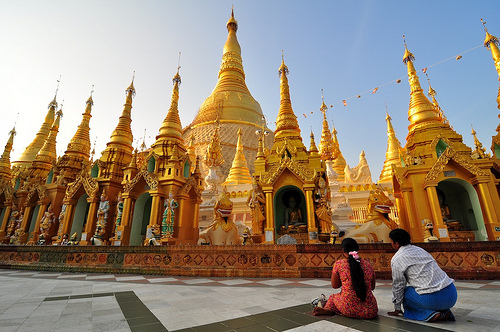
Praying couple at Shwedagon Pagoda in Yangon, Myanmar. Photo: Roger Price / Flickr
Moral dilemma: there’s a country with wonderful sites you’d love to see, but your tourist dollars might end up in the pockets of a military regime. Should you still go?
That’s the central theme in this New York Times article: Visiting Myanmar: It’s Complicated. Since the nation has made small steps toward political reform, the U.S. has removed sanctions. This has created an influx of tourists, NGOs and businesspeople into the Southeast Asian country. However, one must pause and consider the ethics of traveling to a country like Myanmar.
As our Rolf Potts has advised in Vagabonding, you can maximize how much of your cash reaches the people by staying in local guesthouses and eating at mom-and-pop restaurants. Stay away from big businesses run as joint ventures with the Myanmar government.
Having been to Myanmar, I can say that it was the highlight of my backpacking trip around Southeast Asia. Magnificent temples, friendly people and an authentic feel that’s missing in more touristy places. It’s a Buddhist wonderland. When friends ask me what it’s like, I tell them, “Going to Burma is the closest I’ve come to feeling like Indiana Jones.”
Have you ever visited a country with a pariah government? It could be Myanmar or somewhere else. Please share your experiences in the comments.
Original article can be found here: Visiting a country ruled by a military junta: right or wrong?
August 5, 2012
Evelyn Waugh on the retroactive nature of “adventure”
Vagablogging :: Rolf Potts Vagabonding Blog
“When we have been home from abroad for a week or two, and time after time, in answer to our friends’ polite inquiries, we have retold our experiences, letting phrase engender phrase, until we have made quite a good story of it all; when the unusual people we encountered have, in retrospect, become fabulous and fantastic, and all the checks and uncertainties of travel had become very serious dangers; when the minor annoyances assume heroic proportions and have become, at the luncheon-table, barely endurable privations; even before that, when in the later stages of our journey we reread in our diaries the somewhat bald chronicle of the preceding months — how very little attention do we pay, among all these false frights and bogies, to the stark horrors of boredom.”
–Evelyn Waugh, Remote People (1931)
(1931)
Original article can be found here: Evelyn Waugh on the retroactive nature of “adventure”
August 4, 2012
Vagablogging field reports: jungle trekking and ancient Mayan cities in Peten, Guatemala
Vagablogging :: Rolf Potts Vagabonding Blog
Cost: $50 a day
What’s the strangest thing you’ve seen lately?
Two days of trekking through muddy paths deep into the mosquito infested jungle of Northern Guatemala’s Peten region brought me and nine other adventurous travelers to the ancient Mayan city of El Mirador. Upon first viewing the ruins I was struck by how thoroughly nature can reclaim its territory after human abandonment. Thick layers of soil and dense vegetation surround, infiltrate and in some cases completely cover structures that are believed to have been abandoned almost two thousand years ago.
Even the higher reaches of the mighty, multi-tiered La Danta temple rising roughly seventy meters (230 feet) from the jungle floor are covered with trees. Archeologists have deliberately left the vegetation there to provide shade and protect the antiquated walls from the debilitating effects of the sun. Without our leather skinned Guatemalan guide Antonio, I’m sure that myself and my compadres would’ve been largely unaware that we were standing on the most massive ancient Mayan structure in the world. Unlike at the more popular site of Tikal it’s easy to mistake parts of the structure for normal contours of the land.
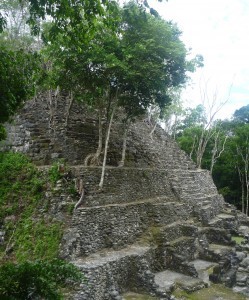
La Danta
Over time it appears that the wilderness can erase almost all traces of a civilization. El Mirador, which is thought to have been populated by as many as 200,000 people at its peak was engulfed by the jungle and only discovered in 1926.
Sitting atop the 55 meter (180 foot) El Tigre temple as the sun set and pink oozed over the horizon like a slow bleed, I pondered the tenacity of nature. As if to punctuate my thoughts some howler monkeys started a chorus of guttural roars, spider monkeys crashed though the canopy and a diminutive humming bird the size of a large insect helicoptered onto a near by branch. Left alone the wilderneas is raw and formidable.

Sunrise from El Tigre
Describe a typical day:
I rise at 4.30am with my tent mates Rune and Raul who share my enthusiasm for watching sunrises from the top of ancient temple ruins. Huffing and puffing we make our way up the steep stairs of El Tigre. The jungle never seems to lose its heat and humidity and we emerge from under the canopy and reach the top panting with sticky skin moist with perspiration. It’s still dark at the top but there is a merciful breeze. The shine of Venus is picked out easily amongst the stars but within a few minutes the sun starts creeping over the edge of the jungle clad horizon and the forest awakens with the discordant sounds of unseen creatures.Howler monkeys covered by a tangle of dark green canopy to the north sound off with their distinctive territorial roars and an almost constant high pitched bleating is commenced by hundreds of tree frogs. We sit in silence and gaze out to the east as the sky turns pink and violet before brightening into the rich blue of day. Once the theater of a jungle sunrise has ceased we make our way back down to earth. ‘That was beautiful’, I remark to the others. It’s a bland and inadequate description for what we have just witnessed.An assortment of Jungle creatures (unfortunately the monkeys were too hard to capture)
On the short walk back to camp mosquitoes thirsty for a blood meal hum around my ears with an irritating persistence. I’m constantly slapping at my head and neck like a mental patient. When we arrive back the other members of our rag tag crew have awoken and Veronica, our sturdy Mayan cook is serving breakfast. Scrambled eggs and beans yet again, it seems we eat nothing else.
After breakfast Antonio takes us hiking through El Mirador’s ancient streets, little more than dirt and mud trails ridden with tree roots ready to trip us up. Antonio is a native of Carmelita the last town bordering the dense sub tropical jungle that makes up the El Mirador basin. Having spent all of his life within or in close proximity to the jungle he has developed an acute eyesight for animal life and spots a small toucan high in a near by tree. It’s grand brightly colored bill is at odds with its tiny body like a huge jewel encrusted crown on the head of a toddler.
We continue on through the Danta complex and up the multi-tiered La Danta pyramid. When we get to the final platform three tall pyramidal structures greet us. Antonio explains to us that the triadic configuration is thought to represent three stars in the constellation Orion that the Maya believed were stones surrounding the fire of creation. Our group disperses to explore the area as we see fit.
I immediately head for the top of the central structure and highest point of the immense pyramid. After climbing a steep wooden set of stairs erected on the eastern face I reach the summit. As I catch my breath I turn around slowly taking in 360 degree views of dense green jungle blanketing the terrain as far as the eye can see. Antonio arrives at the top a short while later and hands me some binoculars. I focus in on a family of howler monkeys napping in a near by tree top. My guide points to a distant branch. ‘Loro’, he says. I squint but I can’t see anything with the naked eye so I focus in on the general spot indicated by his index finger and a colorful parrot pops into view. Resplendent in its bright green, red and blue plumage the parrot sits serenely, perhaps surveying the landscape like I am. My fellow hikers join me atop La Danta and we spend the next hour spotting wildlife and examining the ruins.
By the time we decide to head back to camp for a late lunch my stomach has taken on the voice of a howler monkey and is rumbling and groaning for food. I see a queer looking black and red bird the size of a turkey leaping and fluttering from branch to branch high in the canopy. It doesn’t appear to be able to maintain flight and its large eyes give it a startled expression that seems to suggest it’s as surprised as I am to find itself so high in the tree tops. Antonio, ever the fountain of knowledge tells us it’s a crested guan and we scamper around the bases of trees trying to photograph the ridiculous feathered creature. It’s quite camera shy and leaps from one branch to the other every time I get it in my sights. Eventually I realize that I’m not going to capture a national geographic worthy shot and we continue on.
My stomach is still growling when we trudge into camp. I wonder what splendid feast Veronica has cooked for lunch and then curse a little under my breath as some scrambled eggs and beans are slopped onto my plate.
The heat and humidity are intense in the early afternoon and I feel as if I’m wrapped in a hot damp towel that I can’t shake off. We are tired from all the trekking over the last three days so the group decides to take a siesta. There’s no respite in our tents from the sauna like conditions and I sweat profusely as I try to get comfortable. An insect crawls across my face and jars me out of my fitful nap. I brush it off my face and my skin crawls.
Later in the afternoon Antonio leads us around more of El Mirador and shows us some highly intricate stucco panels depicting ancient Mayan myths. He tries to explain the myths depicted but their significance is somewhat lost on me due to my poor Spanish. Never the less I’m quite happy to admire the effort and workmanship put into these walls so many years ago.
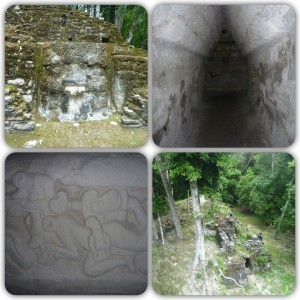
Exploring the ruins
The whole crew decides to head up to El Tigre again later in the day to watch the sunset. It doesn’t disappoint and red and orange hues light up the undersides of the clouds like hot coals. When darkness finally descends we carefully make our way down the staircase. Hundreds of fire flies moving in slow motion through the inky air flicker like old light bulbs striving to stay alight.
Back at camp I sit at the dinner table with my weary companions and the mood is somewhat glum. Tomorrow we begin the two day trek through the mud and mosquitoes back to Carmelita. I have resigned myself to another serving of scrambled eggs and beans and as I start feeling a little sorry myself Veronica surprises us all with a delicious chicken soup. The absence of rubbery scrambled eggs on my plate overjoys me and I feel invigorated and ready for tomorrow’s trekking. Immediately after dinner I head to the tent. Sleep comes easy.
Describe an interesting conversation you had with a local:
Whenever I go into the wilderness I like to be well informed on all the horrific ways that I could potentially die, and in particular what animals inhabiting the area have the ability to maul or maim me. Because of this my first conversation with our guide Antonio was on the topic of jaguars. According to Antonio there are hundreds of jaguars in the El Mirador basin, however unlike in the movie Apocalypto, in real life jaguars don’t tend to eat people’s faces. They are supremely elusive and generally afraid of humans despite being powerful predators. In over ten years that Antonio has been leading treks into the interior of the Peten jungle he has only seen three jaguars. I get the feeling that the jaguars see him a lot more than he sees them.
What do you like about where you are? Dislike?
The thrill of seeing and hearing the abundant wildlife from the top of an immense and remote temple built in antiquity by citizens of an abandoned ancient metropolis almost 2000 years ago is a truly unforgettable experience.
Like any jungle environment Peten is rich in insects of all shapes, sizes and colors. I’m not fearful of creepy crawlies and I usually find them fascinating rather than grotesque. However it’s disconcerting, to say the least, when a big bug awakens you from your slumber as it crawls across your bare skin. Every day several insects, the likes of which I had never encountered before would land on me. I’m sure most of them were harmless but it’s impossible to know if the huge proboscis on your new friend is built for extracting nectar or penetrating flesh.
In addition to the new varieties of insects I encountered there is an incalculably huge number mosquitos. These disease riddled vectors with unquenchable thirsts for human blood necessitate the use of DEET, long pants and long sleeved shirts, none of which are particularly pleasant when your slogging through muddy paths in a sauna like climate.
One must also keep an eye out for ants. If you unknowingly step on them they have a nasty habit of latching onto your shoe before making the journey up your trouser leg to your inner thigh. Once they have reached this particularly sensitive area they decide to sink their pincers in. Over the course of the trek this happened to me more than I care to remember and invariably resulted in me shrieking, before performing a strange jigwhilst slapping at my inner thighs like some drunk yokel dancing to his favorite jangle.
Describe a challenge you faced:
The challenging terrain, mosquitoes, heat and humidity are unpleasant and certainly not for everyone. For me the chance to see incredible Mayan ruins devoid of other tourists and abundant in wildlife more than made up for the discomfort and I would recommend the trek for anyone with similar interests and a lust for adventure. Of course there are other ways to see El Mirador and with the right amount of funds you can do a Mel Gibson and helicopter your way in. But where’s the fun in that?
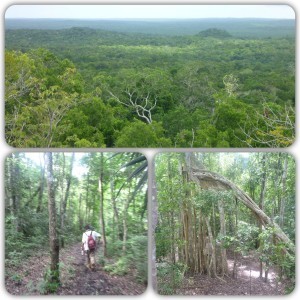
The jungle of El Mirador Basin
What new lesson did you learn?
The human race is capable of incredible feats and the ancient Maya were no exception to this. They had a written language and knowledge of celestial workings but they never invented the wheel. Because of this the temples and other structures we see today were built largely by hand with teams of men lifting immense limestone rocks into place. Millions of man-days labor were spent erecting La Danta alone and it’s a testament to the vision and determination of the former inhabitants of this part of the world.
Despite the impressive achievements of the ancient Maya their total abandonment of large cities like El Mirador undeniably reveals the fallibility of humans. These days most researchers agree that the reasons for the ancient Mayan civilizations collapse were multi-factorial. Environmental degradation, overuse of limited resources and war were largely to blame and these problems still plague many societies today. It’s a worrying thought indeed.
You can follow me on twitter @ash_jordan and instagram @ashgjordan
My email is ash.g.jordan@gmail.com
If you would like to read more about El Mirador please click here for a great article
Original article can be found here: Vagablogging field reports: jungle trekking and ancient Mayan cities in Peten, Guatemala
August 3, 2012
Special August 2012 fares for multi-stop tickets on BootsnAll
Vagablogging :: Rolf Potts Vagabonding Blog
Everyone has memorable travel moments from their lives. It could be from family trips when young. It could be from a study abroad opportunity, or maybe that first independent trip you took without your parents.
No matter what those memories are, chances are another person was involved. It could be someone you went on that trip with, or it could be someone you just met on the road. But the experiences you have with other people are often just as memorable as the place you are visiting.
Which is over at BootsnAll we developed our new traveler profiles – to connect travelers with other travelers, particular those interested in long-term, indie travel.
The travelers who have filled out these profiles do so to share their experiences with others. There are several cool things about these profiles that will benefit all independent travelers.
They are completely sortable – so if you are interested in visiting Chiang Mai, Thailand, you can sort by those travelers who claimed Chiang Mai as their favorite city . If you plan to travel as a couple, you can sort to find those travelers who hit the road together .
If you don’t know where to begin when it comes to planning your round the world trip, each traveler has a map attached to their profile with their round the world route. Check out each person’s trip for inspiration, and if you like one in particular, you can customize or get pricing on the flights for that trip.
Anyone can fill one out. You don’t have to have gone on an extended trip. If you are interested in long term travel, then fill one out with your dream destinations and trips.
If you are ready to hit the road for a big trip, then check out BootsnAll’s monthly airfare deals. The following are good through August 31, 2012:
The Wanderer -New York – Shanghai – Bangkok – Rangoon / Yangon – Singapore – Bali (Denpasar) – Kuala Lumpur – Kathmandu – OVERLAND – Delhi – Istanbul – London – OVERLAND – Paris – New York from $2984 plus taxes.
Exotic Adventure – Los Angeles – London – Johannesburg – Mahe (Seychelles) – Dubai – Singapore – Brisbane – OVERLAND – Sydney – Auckland – Papeete (Tahiti) – Los Angeles from $3626 plus taxes.
Latin Circuit – Miami – Quito – Lima – Santiago – Buenos Aires – Sao Paulo – Miami from $1599 plus taxes.
If you are looking for something a little different in your round the world trip, then start planning your trip of a lifetime with our RTW trip planner And don’t forget to sign up for BootsnAll’s RTW newsletter, delivering special deals, RTW trip planning advice, and resources via email every single month. We also have a Facebook fan page and Twitter page, so be sure to like and follow those to keep up to date on all your RTW travel needs.
Original article can be found here: Special August 2012 fares for multi-stop tickets on BootsnAll
August 2, 2012
The reality of the travel writer, part I
Vagablogging :: Rolf Potts Vagabonding Blog
I’m often asked about what it’s like to be a travel writer. I find that most people assume that it’s always fun and high-paying, which isn’t necessarily the case. I feel compelled to address some of these realities in this mini-series of blog posts.
Unlike the life of the Matthew Hunt, the travel writer protagonist of my new soon-to-be-finished novel, it isn’t especially glamorous, adventurous, or dangerous.
As I at the beginning of the book when introducing the character, “He smiled ruefully to himself at people’s perceptions of his occupation. They envisioned all-expenses-paid trips to exclusive resorts, but that was not the reality. Interesting things rarely happened at exclusive resorts. He rolled his shoulders and brought his hand to his neck, which had a crick in it from sleeping on thin mattresses in grimy urban hostels and the hard, gritty ground under the starry Saharan sky.”
And unlike him, most travel writers don’t receive a phone call from a magazine editor asking them to cover an exotic place (and solve a historical mystery while they’re at it).
In real life, getting the job is often a time-consuming process every freelance writer knows well: the query. The writer comes up with a location or a topic, finds the appropriate magazine or webzine to approach, and pitches the proposal to an editor. Often the query will languish in the person’s inbox, unintentionally missed because the head honcho is too distracted by the tortuous time demands of a tight publication schedule.
After a follow-up message, and then a few more follow-ups bordering on harassment, the editor might just be motivated to look at your proposal just to shut you up. If it’s on a location or topic within their purview, and one they haven’t covered recently, the editor might get back in touch to discuss the idea further.
This is the time to make your best pitch and have samples of your previous work ready to show off (if they haven’t already dealt with you). They talk to lots of travel junkies and wanna-be writers. As a result they’re hard to impress. Your challenge is to show them you’re a professional who knows how to craft a compelling, rich portrait of a place or experience that gives the reader insight. Show them that you can splice in humor and practical tips too (such as airport info, hotel info, festival dates and museum opening/closing hours, etc) if it’s appropriate for the publication or website. Most importantly, show that you know the subject and are enthusiastic about bringing it to life for the reader. Be enthusiastic about sharing what you know.
This is just a taste of the initial, mundane—but essential—process of getting the job. Next time I’ll go a little more in-depth as to what the travel writer’s life is like once that coveted assignment has come though and the contract for the gig is signed.
Original article can be found here: The reality of the travel writer, part I
Take the bus to discover a city
Vagablogging :: Rolf Potts Vagabonding Blog

Public buses in Mahendranagar, Nepal - picture by Kit Yeng Chan, 2012
Since I got my own transport – a small 4 strokes Japanese motorbike -, I have not been considering the bus as a proper way of traveling. Instead, a bus line can be a great way to discover and feel a new city. I reconsidered this lost travel art while I was waiting for visa processing in Bangkok: staying for too many days, the sky train and the metro system were increasingly affecting my daily budget.
On the other hand, the bus system in Bangkok is daunting: hundreds of vehicles of different color, shape and form. To make things worse, add up a population who can barely help when asked for directions in English, and a different language system – impossible to decipher for starters – as the only reference for the bus timetables.
Nevrtheless, as I consider vagabonding an interesting everyday cultural challenge, I decided to go for the daunting bus system. And I discovered a few great things: first of all, during peak hours, buses in Bangkok are free of charge to help decongesting the traffic by encouraging people to leave their cars home. Second, some of the routes link places faster than the metro or the sky trains, which are fast but have quite restricted operational areas. Third, the bus is extremely cheap, the few times you pay for it. And fourth, this exercise immensely helped me memorize better the geography of Bangkok, an otherwise burgeoning, controlled chaos.
Fast forward to the present days, and another visa wait – how I love you, wasted travel days spent around concrete cities to get new elaborated tattoos in my passport!! – in Urumqi, extreme Northwestern China. Some people say “the center of Asia” by tracing two diagonal lines across a map of the continent. A city embedded in the sandy, camel trodden imagination of ancient Silk Road’s paths: in reality, just another orderly, neatly steamrolled Chinese Nirvana perched at the edge of a desert and a mountain range. Getting off the train and walking into the station’s main square for the first time, Urumqi’s size looked, again, daunting. The bus stand was just there, luckily. After checking a few times with several people to match the directions in Chinese characters with the right bus line, there I was, again, looking outside the window and enjoying some fresh Xinjiang’s summer air.
At first, the city looked like a colossus of neatly arranged busy streets, crazy intersections full of little shops stacked one against the other like an infinite series of pouty mushrooms, each with a different, colorful hat. It took me a couple days to be able to reconsider Urumqi’s topography from the window of my favorite three bus lines, all connecting the place I was staying with different points of interest around the city. Each time it was like streamlining the city by dropping a long, invisible wire all along the bus routes. The buildings became more familiar: recognizing some of them and forecasting the next turn of the stuttering bus, I felt an instinctive great joy. Urumqi was unwinding before my eyes, and I actually understood where I was going. After two days, I finally realized that the city was only half the size of what I had previously sized stepping off the train for the first time. And for this reason, I can only suggest you to consider intercity bus travel as a great, cheap way to discover a city, indulge in curious people watching, and ultimately getting to know a city’s underbelly almost like a local. Get on a bus and let it ride: after a long while, you will be returned at your original starting point, with a much better knowledge of your new environs.
Original article can be found here: Take the bus to discover a city
Rolf Potts's Blog
- Rolf Potts's profile
- 323 followers







